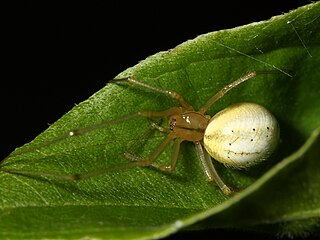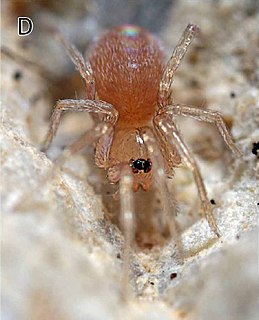
Theridiidae, also known as the tangle-web spiders, cobweb spiders and comb-footed spiders, is a large family of araneomorph spiders first described by Carl Jakob Sundevall in 1833. This diverse, globally distributed family includes over 3,000 species in 124 genera, and is the most common arthropod found in human dwellings throughout the world.

Anyphaenidae is a family of araneomorph spiders, sometimes called anyphaenid sac spiders. They are distinguished from the sac spiders of the family Clubionidae and other spiders by having the abdominal spiracle placed one third to one half of the way anterior to the spinnerets toward the epigastric furrow on the underside of the abdomen. In most spiders the spiracle is just anterior to the spinnerets. Like clubionids, anyphaenids have eight eyes arranged in two rows, conical anterior spinnerets and are wandering predators that build silken retreats, or sacs, usually on plant terminals, between leaves, under bark or under rocks. There are more than 500 species in over 50 genera worldwide.

Oonopidae, also known as goblin spiders, is a family of spiders consisting of over 1,600 described species in about 113 genera worldwide, with total species diversity estimated at 2000 to 2500 species. The type genus of the family is OonopsKeyserling, 1835.

Corinnidae is a family of araneomorph spiders, sometimes called corinnid sac spiders. The family, like other "clubionoid" families, has a confusing taxonomic history. Once it was a part of the large catch-all taxon Clubionidae, now very much smaller. The original members of the family are apparently similar only in that they have eight eyes arranged in two rows, conical anterior spinnerets that touch and are generally wandering predators that build silken retreats, or sacs, usually on plant terminals, between leaves, under bark or under rocks.

The ray spiders (Theridiosomatidae) are a family of spiders first described by Eugène Simon in 1881. They are most recognizable for their construction of cone-shaped webs.
Tenedos is a spider genus of the family Zodariidae. It has around 72 species from Central and South America.

Actinopus is a genus of mygalomorph spiders in the family Actinopodidae. It was first described by Josef Anton Maximilian Perty in 1833 from the type species Actinopus tarsalis found in Brazil. The name is derived from Greek actin- "ray, beam" and pous "foot". It is a senior synonym of Aussereria, Closterochilus, Pachyloscelis, and Theragretes.

Cithaeronidae is a small family of araneomorph spiders first described by Simon in 1893 Female Cithaeron are about 5 to 7 millimetres long, males about 4 millimetres (0.16 in).
Myrmecium is a genus of ant-mimicking corinnid sac spiders first described by Pierre André Latreille in 1824. The unrelated jumping spider species Synemosyna formica has been mistaken for a member of this genus twice, once by Eugène Simon in 1897 and once by Cândido Firmino de Mello-Leitão in 1932.

Ariamnes is a genus of comb-footed spiders that was first described by Tamerlan Thorell in 1869. Some species have greatly elongated abdomens, making them resemble a twig.

Glenognatha is a genus of long-jawed orb-weavers that was first described by Eugène Louis Simon in 1887. It was considerably revised in 2016.

Corinna is a genus of corinnid sac spiders first described by Carl Ludwig Koch in 1841. They are found in Mexico and south to Brazil, and with selected species found in Africa.

Elaver is a genus of sac spiders first described by Octavius Pickard-Cambridge in 1898.
Abapeba is a genus of Central and South American corinnid sac spiders first described by A. B. Bonaldo in 2000.

Strotarchus is a genus of araneomorph spiders in the family Cheiracanthiidae that was first described by Eugène Louis Simon in 1888. Originally added to the Clubionidae, it was moved to the Miturgidae in 1967, and to the Cheiracanthiidae in 2014. It is considered a senior synonym of Marcellina and Coreidon.

Neospintharus is a genus of comb-footed spiders that was first described by H. Exline in 1950. It was synonymized with Argyrodes in 1962, but revalidated in 2004.

Ogulnius is a genus of ray spiders that was first described by Octavius Pickard-Cambridge in 1882.

Arachosia is a genus of anyphaenid sac spiders that was first described by Octavius Pickard-Cambridge in 1882.














